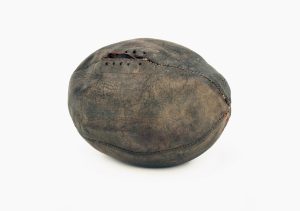Rugby balls are elongated ellipsoidal balls that have been used in the sport of rugby since the 19th century. The earliest balls were designed and manufactured by Richard Lindon and Bernardo Solano and were made from hand-stitched leather casings and the bladders of pigs. In the earlier days, the size of rugby balls varied because they were determined by the size of the pig’s bladder with many earlier balls being shaped more like plums than ovals. It’s remarkable to see the difference when you compare the rugby balls of the 19th century with those of today.
Rugby balls have massively improved over the years. The rugby balls of today are the result of decades of testing, feedback, research and development. The reason rugby balls are shaped as they are is that they are ideal for catching, running with and don’t go out of play as much as other styles of the ball would.
When rugby balls were first designed, making them appear substantially different from footballs was regarded as a big priority. And, in 1892, it was made compulsory by the RFU that all rugby balls were to be an oval shape.

Richard Lindon and William Gilbert created the first balls for Rugby school, said to be the birthplace of the game and the inspiration for the name of the sport. Lindon and Gilbert were owners of nearby shoe-making businesses, hence their close relationship with the school.
Originally, Lindon lived at 20 High Street, with Gilbert living at number 20. The street led directly to the quad entrance of the school, where both boys played quad ball (football as we know it today) before there were playing fields at Rugby school. As time went on, William Gilbert's shop moved to 5 St. Matthews Street, in 1842. This was directly opposite The Close, which was the playing field for Rugby School. Lindon’s shop was directly opposite the Quad Entrance on 6 Lawrence Sheriff Street. By the 1850s, both men had become the two main suppliers of pig’s bladder and leather-clad balls to the boys at the school.
The method of inflating the pigs’ bladders for rugby balls was not a pleasant one. To inflate the bladders, the stem of a clay pipe was inserted into them. The bladders were particularly foul-smelling, and the process could even be fatal if the bladder turned out to be diseased. It’s thought that Richard Lindon’s wife’s death was linked to frequent inflation of rugby balls.
Richard Lindon was desperate to replace pig’s bladder with a different material, especially after his wife fell ill. In 1862, he decided to use India rubber bladder instead. However, inflating the material by mouth was simply too tough. Therefore, he created a brass version of an air syringe in order to inflate his rugby balls.
In 1870, Richard Lindon started to use rubber inner tubes rather than pigs’ bladders. The new material also caused the shape to change to an egg-shape from a sphere. The compulsory shape became oval in 1892 due to rules introduced by the RFU.

Initially, balls had to have an end-on circumference of 30-31 inches, a width circumference of 25.5-6 inches and a length of 11-11.25 inches. The weight had to be between 12-13 inches and the ball needed to be handsewn. It also needed at least eight stitches to the inch.
Lindon had claimed that he had invented the rugby ball and the distinctive oval shape of it. However, he did not patent the ball, or the pump or bladder. By the 1880s, there were a number of different manufacturers using the same process as him across England.
The ball would continue to become flatter as the decades went by. Leather was eventually replaced by synthetic material. One of the reasons for this was to stop weather affecting games. Synthetic material was regarded as a better option due to the way it didn’t absorb water and therefore become heavy. This was a problem frequently experienced when leather balls were used in wet conditions. Leather was replaced in the early 1980s. The first supplier of synthetic rubber bladders for the game was Charles Macintosh, the famous raincoat manufacturer.
A typical rugby ball today consists of four panels that have been stitched together to form an oval shape. The length of a rugby ball is usually about 30 cm and the weight must not be more than 460 grams. Moreover, when the game starts the ball must have an air pressure of approximately 0.70 kg/cm2.
You might think a rugby ball is just a rugby ball, right? Oh, but you'd be mistaken! When it comes to the nitty-gritty of rugby, the devil is in the details - especially when you're talking about Rugby Union vs. Rugby League balls. Let's get one thing straight: both types of rugby balls have that iconic, slightly oblong shape that you could never mistake for, say, a soccer or basketball. But here's where the subtleties kick in.
The ball for Union is elliptical in profile and a prolate spheroid shape. The regulation ball is of the following dimensions; 28 to 30 cm in length x 58 to 62 cm in circumference. Or, in other words; 11 to 12 inches in length x 23 to 24 inches in circumference – this is taken at the widest point. When it is full size, it weighs between 410 g and 460 g.

A Rugby Union ball is generally larger and a tad more rounded, offering a greater surface area for those tricky line-out throws and scrums. It’s designed to not only be kicked but also to sit more securely in the player's hands for those beautiful running plays.
On the flip side, the Rugby League ball is a bit sleeker and more pointed. It is typically made from brown leather. The size of the rugby ball used in the Rugby League is as roughly as follows; 27 cm in length x 60 cm in circumference or in other words 11 inches in length x 24 inches in circumference. The circumference is taken at the widest point. A rugby ball of full size should weigh between 383 g and 440 g. If a ball does not meet the standards that are put in place the game will be stopped instantly.
This gives it a different aerodynamic profile that's better suited for the kind of rapid, pinpoint passing you'll see in a League match. You could think of the Rugby Union ball as the Swiss Army knife of rugby balls, versatile and reliable, while the Rugby League ball is more like a scalpel—sharp, precise, and specialised for its game.

Most professional rugby leagues use balls made by brands like Steeden, Rhino, Mitre, or Gilbert. In rugby league, balls are inflated by nitrogen. Rugby balls come in a host of patterns and colours, though senior competitions are expected to opt for light coloured balls as it is easier for spectators and viewers at home to see these. There are subtle differences between the balls used for rugby league and rugby union. Balls used in rugby league are slightly more pointed than their rugby union counterparts. Although rugby league footballs may well look similar to American footballs, they are in fact larger.
Gilbert is one of the most well-known rugby ball manufacturers in the world. When James Gilbert’s father passed away in 1917, he threw himself into the family business, feeling determined that the Gilbert brand's reputation for quality should not be compromised. He even checked and stamped each match ball himself. Gilbert has been the official manufacturer and supplier of Rugby World Cup balls since 1995 and continues to be the most prestigious brand in the world of rugby ball manufacturing and design.
So, the next time you find yourself deep in a debate about rugby—or perhaps deep in the design process of crafting the next great sports product—remember that the right ball really can make all the difference.
This article is part of our famous designs series, we've also done articles on